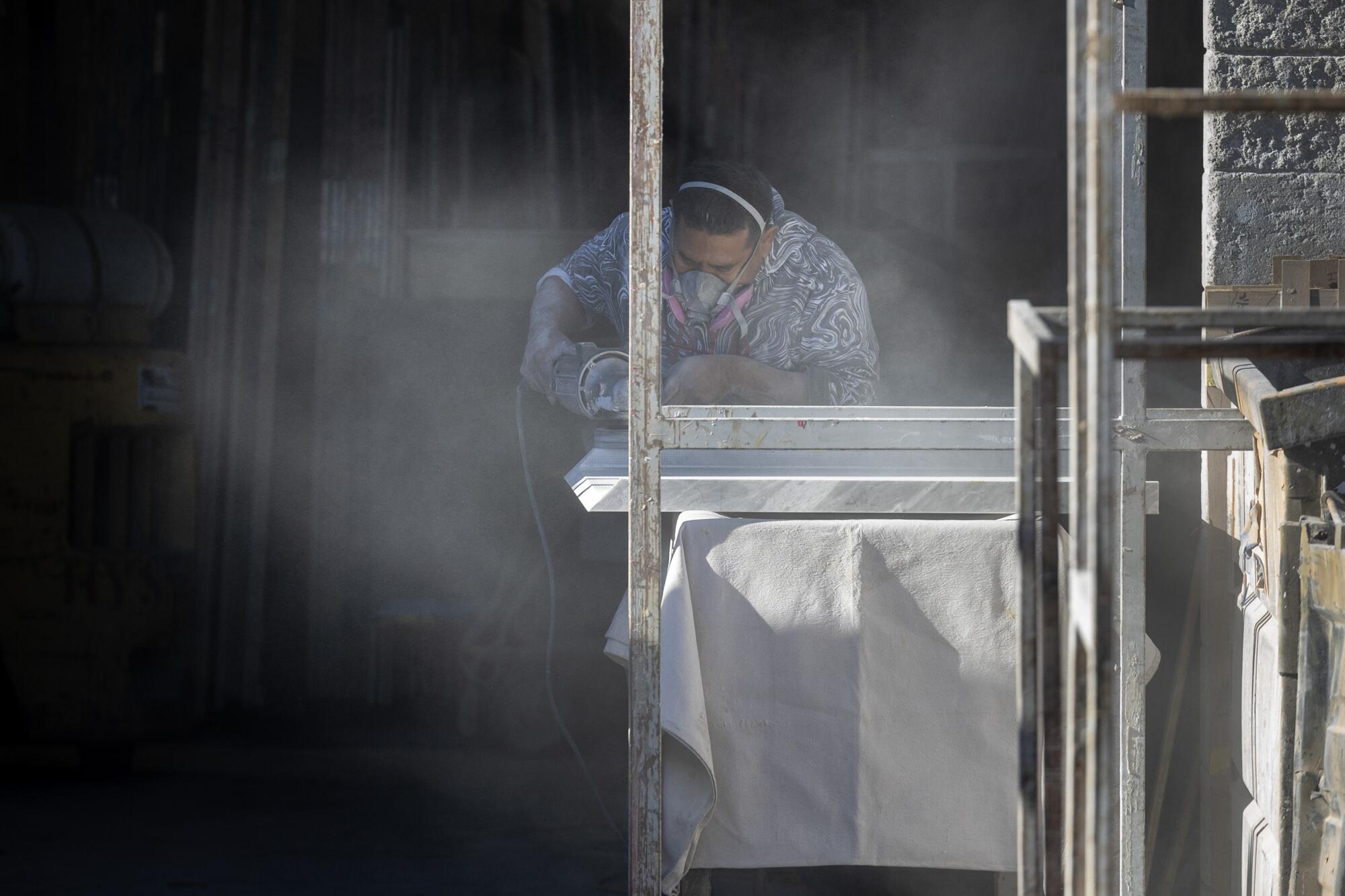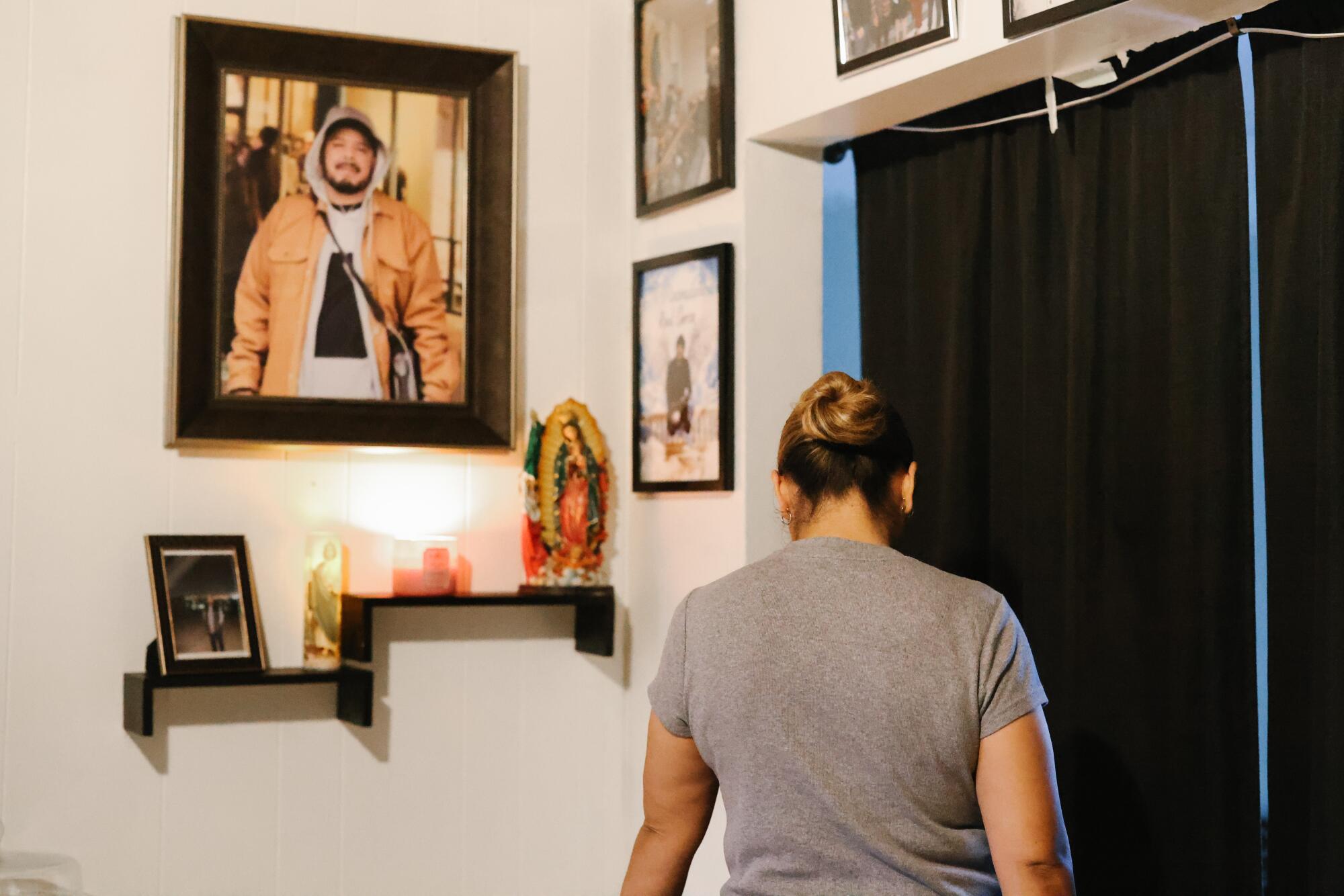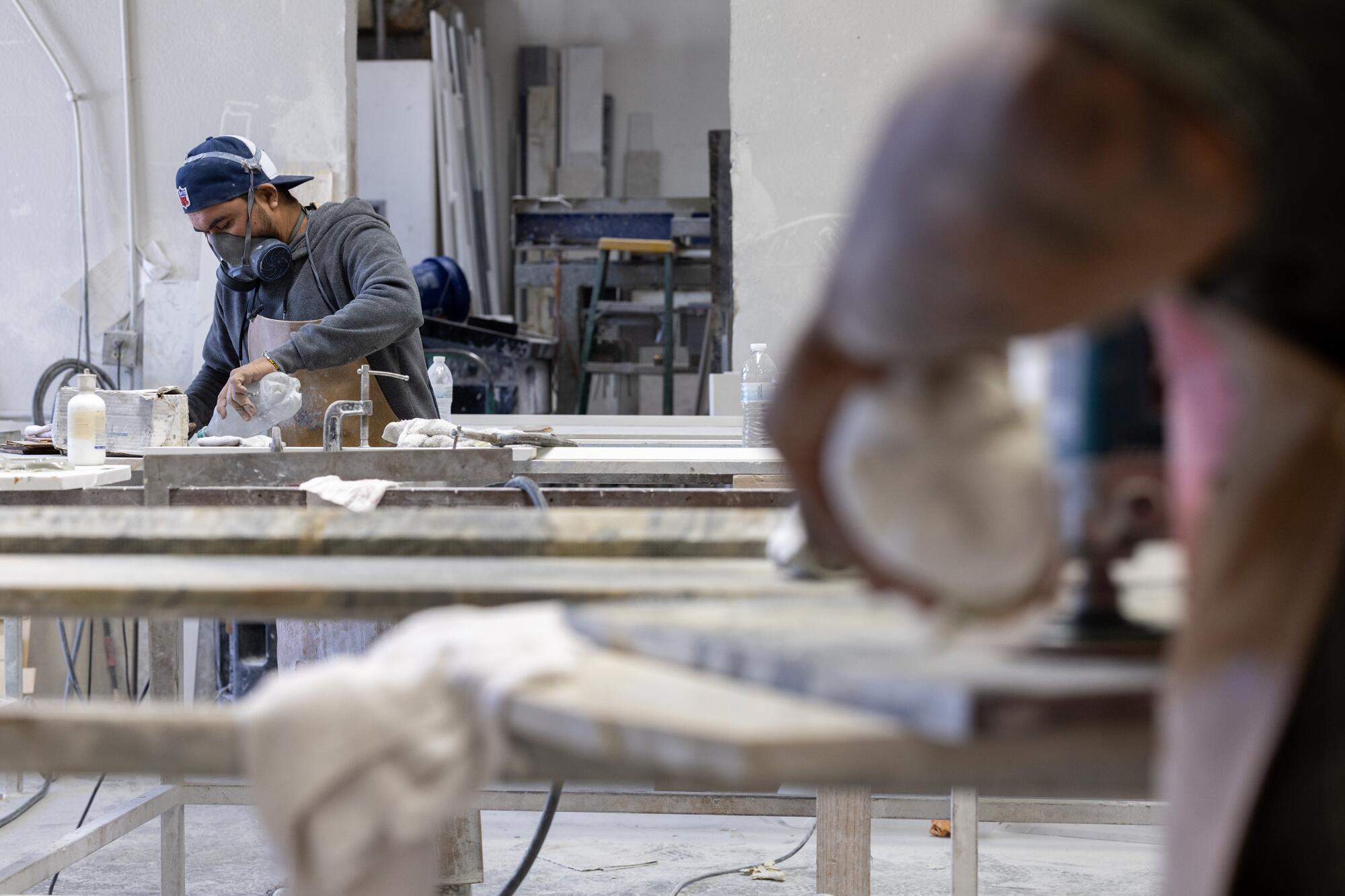
- Share via
When Wendy Solano first heard the word “silicosis,” her husband Jose Raul Garcia Leon was already suffering from the incurable disease that would kill him.
After immigrating from Mexico, the father of three had provided for his family by cutting countertops. His illness began as a dry cough — something the couple had chalked up to allergies or the changing weather — and rapidly became so debilitating that he grew exhausted trying to speak, Solano said.
Leon died months after joining the waitlist for a lung transplant. Near the end, he could no longer speak, his lungs irreparably damaged by the pale dust that coated his clothes and head when he returned from work.

He was 46 years old.
The deaths of workers like Leon, some barely at middle age, have alarmed California lawmakers and regulators as dozens of cases of the suffocating illness have emerged among people who cut and grind countertops. Physicians have linked the silicosis outbreak to the booming demand for engineered stone, a synthetic material much higher in lung-scarring silica than natural granite or marble.
Yet the threat of silicosis is far from a new one, known for centuries as a hazard to workers breathing in tiny particles of crystalline silica. And more than a decade before Leon died, researchers had already raised alarms about the renewed threat of silicosis specifically among workers cutting engineered stone, which has surged in popularity since the turn of the century.
Many experts said the risks should have been anticipated and averted long before young men like Leon started dying.
“It still astounds me as to how glacial the pace has been” to tackle the problem, said Dr. Ryan Hoy, who leads an occupational respiratory disease clinic at Alfred Hospital in Melbourne, Australia.
“This is an epidemic of silicosis — a completely preventable lung disease — in this industry all for the sake of having a fashionable kitchen countertop,” Hoy said. Regulators should be looking at the risks of any new material, he said, not “waiting until patients and workers are dying and then doing something.”
The booming popularity of countertops made of engineered stone has driven a new epidemic of silicosis, an incurable lung disease, researchers have found.
But California physicians and scientists trying to raise alarms have faced a host of obstacles. Silicosis takes years to become apparent after workers are exposed, and the disease has often been mistaken for other ailments by physicians unaware of its modern resurgence. Immigrant workers may hesitate to seek medical care, preventing their illnesses from being detected promptly by health officials.
Dozens of California cases have been tallied so far, but that’s “just the tip of the iceberg,” said Dr. Amy Heinzerling, chief of the emerging workplace hazards unit at the California Department of Public Health. Regulators estimate the state is home to more than 800 shops where engineered stone is readied for installation in kitchens and bathrooms — and believe the bulk are out of compliance with silica rules. “There are almost certainly more cases out there that we don’t know about.”
::
Silicosis is one of the oldest occupational diseases on the globe. The deadly toll of dust on miners and stonecutters was detailed by European scholars in the 1500s and 1700s. During the Great Depression, silicosis killed hundreds of workers — most of them Black men — who drilled a West Virginia tunnel, a disaster that spurred a national campaign by labor officials to “Stop Silicosis.”
Deaths from silicosis plummeted in the U.S. between 1968 and 2002, with a 93% decline in the rate of silicosis deaths in that time, according to the Centers for Disease Control and Prevention. The International Labour Organization and the World Health Organization launched a program to eliminate silicosis worldwide by 2030.
But the threat never disappeared, afflicting workers who were sandblasting denim and tombstones and toiling in mines. And as new forms of silica exposure arose, that goal of eliminating silicosis by 2030 has become an unlikely one, said Dr. Francisco Santos-O’Connor, senior specialist in occupational safety and health at the ILO.

Physicians have linked many recent cases to the rise of engineered stone in the international market. In the 1970s, an Italian entrepreneur developed the technology to bind crushed stone together with resin and produce slabs of artificial stone. Among the first companies to manufacture it was Caesarstone, which set up a factory in 1987 at an Israeli kibbutz.
Doctors in Israel began to spot silicosis cases among such workers between 1997 and 2001, but “these were scattered events,” they wrote in the medical journal Chest, and “we did not appreciate the nature of the outbreak” at first. By the time they published their findings in 2012, they had found more than two dozen cases among stonecutters working with a “relatively new, artificial, decorative stone product.”
At that point, silicosis cases had also been detected in Spain, where engineered stone had gone into production. More cases arose in Italy and Australia as well.
Hoy said that long before stonecutters started struggling to breathe, the sheer amount of silica in many kinds of engineered stone — upwards of 90% — should have made it obvious that the material was risky to cut and grind, especially in workplaces without sophisticated measures to control dust.
“Silica is an occupational hazard that’s been known about for well over a century ... longer than asbestos, longer than tobacco smoking,” Hoy said. But as engineered stone grew into a global industry worth more than $20 billion, “all our worst fears have kept coming true.”
Physicians have been alarmed to see young men sickened after a decade or less of workplace exposure. In the U.S. and elsewhere, laborers cut the high-silica material in the same shops where they had toiled over marble or granite — and using the same methods, including “dry cutting” without any water to suppress dust.
The fabrication shops where workers cut and polish slabs are typically divorced from the engineered stone manufacturers that supply the material. That complicates information sharing and enforcement, said Dr. Robert Harrison, a public health medical officer with the California Department of Public Health.
The U.S. has tightened limits for how much silica workers should be exposed to, but “the real problem is that OSHA” — the federal Occupational Safety and Health Administration — “is incredibly underresourced,” said Dr. Cecile Rose, a pulmonologist at National Jewish Health in Denver. “They do not have enough funding to be able to go to all the workplaces” where silica could put people at risk.
Silicosis, a disease caused by silica dust produced when workers cut and grind engineered stone, is afflicting workers. What consumers can do about it.
Industry groups have placed the blame on unsafe practices by fabrication shops rather than the material itself. Facilities where regulations are not enforced have endangered workers by neglecting “fundamental safety precautions,” said Eric Rose, a spokesperson for the Stone Coalition, which includes manufacturers, fabricators and distributors across the country.
“Silicosis is almost entirely preventable,” he said. “Any contractor who adheres to Cal/OSHA guidelines can ensure the safe cutting of all types of stone, be it engineered or natural, with minimal risk to their workers.”
But scientists and regulators have grown concerned about whether recommended strategies such as wet cutting, proper ventilation and wearing respirator masks can do enough to protect workers from dust so high in silica. Cal/OSHA officials have generally described silicosis as preventable, but also caution that with 93% silica content, “safe use of engineered stone may not be possible” even with proper workplace practices.
In Australia, workplace safety officials recently recommended a total ban on engineered stone, calling it “the only way to ensure that another generation of Australian workers do not contract silicosis from such work.”
::
More than a decade ago, U.S. physicians began seeing reports from abroad about the risks of cutting engineered stone and realized that silicosis could soon afflict workers here.
Just a few months after a CDC blog post in 2014 warned of the possible threat, health officials in Texas learned that a 37-year-old worker was suffering from the disease — the first reported case tied to high-silica countertop cutting in North America, according to researchers.
Five years later, U.S. researchers had tallied 18 such cases in four states. Among them were six men from California, all working for the same company. Public health investigators found the first one using state data about hospital discharges, identifying a young man who had cut countertops for nearly a decade.
But researchers often do not get information about hospital discharges until a year or more later, Heinzerling said. By the time the researchers learned about that first patient, he had already died at the age of 38.

This is an epidemic of silicosis — a completely preventable lung disease — in this industry all for the sake of having a fashionable kitchen countertop.
— Dr. Ryan Hoy, who leads a respiratory disease clinic in Melbourne, Australia
Scores of silicosis cases among California countertop workers have been reported since 2019, the bulk of them in Los Angeles County, where small workshops are tucked into industrial stretches of the San Fernando Valley. The numbers have rapidly escalated, with roughly half of the 93 known cases identified this year alone. At least 10 countertop workers across California have died of the disease.
Physicians fear many more cases have gone undetected. A study by researchers at UCLA and UC San Francisco found that among dozens of California countertop workers with silicosis, more than half were initially misdiagnosed with other ailments.
“They kept working. They kept being exposed. They were getting medical care that wasn’t the right medical care and it was delaying their actual diagnosis — and they were getting worse,” said Dr. Sheiphali Gandhi, a pulmonologist at UCSF. Part of the problem is many physicians “just don’t think that this can happen anymore.”
Many doctors do not routinely ask patients about the work they do. Even when cases of silicosis are recognized, California physicians haven’t been required to report them to health officials — something the public health department is now working to change.
Then there is the question of whether suffering workers see a doctor at all. Gandhi said California has more expansive health coverage for undocumented immigrants than many other states, where such workers might have more difficulty accessing medical care.

The National Institute for Occupational Safety and Health said it cannot track the number of silicosis cases tied to countertop cutting across the U.S. because health records don’t typically include the work done by patients. Nor is there a global system for tracking such threats, experts said. Cecile Rose and her colleague Dr. Jeremy T. Hua are building an international registry of silicosis cases to better understand the scope of the problem.
In Australia, which is now weighing a national ban on engineered stone, government leaders took action after workers began telling their stories. Among them was Anthony White, a Queensland stonecutter whose illness and death at age 36 were widely covered there.
But in the U.S., many immigrants suffering from silicosis were initially reluctant to speak publicly, Gandhi said. The tiny shops where countertop cutters work are not generally unionized, leaving employees fearful of losing their jobs and unlikely to complain to government agencies, Cal/OSHA officials said in a report.
Changes are now in the works in California: After finding widespread violations of a state standard meant to protect workers from silica, Cal/OSHA is hustling to draft emergency rules. If employers don’t follow them, the agency says it could consider a ban on engineered stone.
State lawmakers are vowing to take action. Los Angeles County is also backing stronger standards to protect workers and considering a possible ban.
There is no excuse to allow dangerous working conditions for a product that is used for purely aesthetic reasons when there are safer options.
Some families are going after the makers of engineered stone in court. Solano is among the plaintiffs in dozens of California lawsuits that argue the slabs are “inherently hazardous.”
Manufacturers have fought such cases: Caesarstone denied that Solano and her children were damaged by “any act or omission” by the company. Cosentino said California courts lacked jurisdiction because the company “has never conducted any business in California.”
In Spain, however, a Cosentino executive admitted in court that its failure to disclose risks caused serious injury to five workers and agreed to pay them and their families more than $1 million. Cosentino said in a statement that it was found liable only for providing “insufficient technical information” to a particular fabrication shop.

Leon died in February after being disconnected from a ventilator at a Los Angeles hospital, his wife said. The couple, who had met when Solano was a teenager, were together for two and a half decades and married in a church. Leon had been a devoted father who showed up at school dances and games and loved dogs and cars and soccer, she said. For a long time, he loved his job too.
Before he died, he knew that Solano was going to pursue the lawsuit against engineered stone manufacturers. She has pressed forward, she said, because her husband was not alone.
“There are many other people whose lives are in danger, because this is not going to stop,” she said.
It’s long been known that “if you inhale high levels of silica dust, you’re going to get silicosis,” said Dr. Paul Blanc, an occupational lung disease specialist at UCSF. But “there is a kind of cyclical amnesia in occupational health where we’re aware of a problem and we give some attention to it, and then there’s a forgetting.”
And, he said, “the economic interests are certainly in favor of forgetting.”
Times staff writer Kate Linthicum contributed to this report.
More to Read
Sign up for Essential California
The most important California stories and recommendations in your inbox every morning.
You may occasionally receive promotional content from the Los Angeles Times.


















